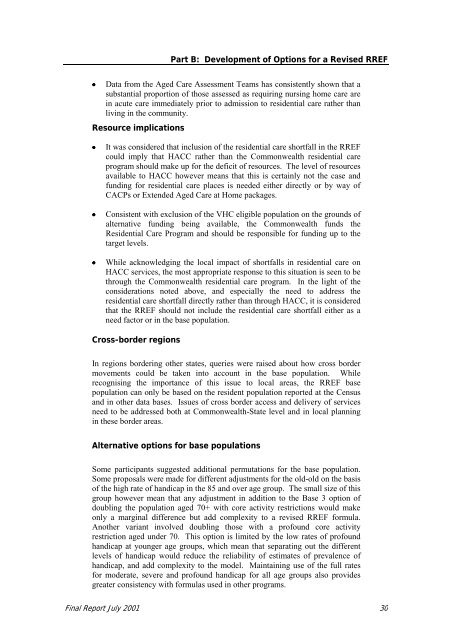Final Report on RREF 2001 - Department of Health
Final Report on RREF 2001 - Department of Health
Final Report on RREF 2001 - Department of Health
You also want an ePaper? Increase the reach of your titles
YUMPU automatically turns print PDFs into web optimized ePapers that Google loves.
Part B: Development <strong>of</strong> Opti<strong>on</strong>s for a Revised <strong>RREF</strong><br />
• Data from the Aged Care Assessment Teams has c<strong>on</strong>sistently shown that a<br />
substantial proporti<strong>on</strong> <strong>of</strong> those assessed as requiring nursing home care are<br />
in acute care immediately prior to admissi<strong>on</strong> to residential care rather than<br />
living in the community.<br />
Resource implicati<strong>on</strong>s<br />
• It was c<strong>on</strong>sidered that inclusi<strong>on</strong> <strong>of</strong> the residential care shortfall in the <strong>RREF</strong><br />
could imply that HACC rather than the Comm<strong>on</strong>wealth residential care<br />
program should make up for the deficit <strong>of</strong> resources. The level <strong>of</strong> resources<br />
available to HACC however means that this is certainly not the case and<br />
funding for residential care places is needed either directly or by way <strong>of</strong><br />
CACPs or Extended Aged Care at Home packages.<br />
• C<strong>on</strong>sistent with exclusi<strong>on</strong> <strong>of</strong> the VHC eligible populati<strong>on</strong> <strong>on</strong> the grounds <strong>of</strong><br />
alternative funding being available, the Comm<strong>on</strong>wealth funds the<br />
Residential Care Program and should be resp<strong>on</strong>sible for funding up to the<br />
target levels.<br />
• While acknowledging the local impact <strong>of</strong> shortfalls in residential care <strong>on</strong><br />
HACC services, the most appropriate resp<strong>on</strong>se to this situati<strong>on</strong> is seen to be<br />
through the Comm<strong>on</strong>wealth residential care program. In the light <strong>of</strong> the<br />
c<strong>on</strong>siderati<strong>on</strong>s noted above, and especially the need to address the<br />
residential care shortfall directly rather than through HACC, it is c<strong>on</strong>sidered<br />
that the <strong>RREF</strong> should not include the residential care shortfall either as a<br />
need factor or in the base populati<strong>on</strong>.<br />
Cross-border regi<strong>on</strong>s<br />
In regi<strong>on</strong>s bordering other states, queries were raised about how cross border<br />
movements could be taken into account in the base populati<strong>on</strong>. While<br />
recognising the importance <strong>of</strong> this issue to local areas, the <strong>RREF</strong> base<br />
populati<strong>on</strong> can <strong>on</strong>ly be based <strong>on</strong> the resident populati<strong>on</strong> reported at the Census<br />
and in other data bases. Issues <strong>of</strong> cross border access and delivery <strong>of</strong> services<br />
need to be addressed both at Comm<strong>on</strong>wealth-State level and in local planning<br />
in these border areas.<br />
Alternative opti<strong>on</strong>s for base populati<strong>on</strong>s<br />
Some participants suggested additi<strong>on</strong>al permutati<strong>on</strong>s for the base populati<strong>on</strong>.<br />
Some proposals were made for different adjustments for the old-old <strong>on</strong> the basis<br />
<strong>of</strong> the high rate <strong>of</strong> handicap in the 85 and over age group. The small size <strong>of</strong> this<br />
group however mean that any adjustment in additi<strong>on</strong> to the Base 3 opti<strong>on</strong> <strong>of</strong><br />
doubling the populati<strong>on</strong> aged 70+ with core activity restricti<strong>on</strong>s would make<br />
<strong>on</strong>ly a marginal difference but add complexity to a revised <strong>RREF</strong> formula.<br />
Another variant involved doubling those with a pr<strong>of</strong>ound core activity<br />
restricti<strong>on</strong> aged under 70. This opti<strong>on</strong> is limited by the low rates <strong>of</strong> pr<strong>of</strong>ound<br />
handicap at younger age groups, which mean that separating out the different<br />
levels <strong>of</strong> handicap would reduce the reliability <strong>of</strong> estimates <strong>of</strong> prevalence <strong>of</strong><br />
handicap, and add complexity to the model. Maintaining use <strong>of</strong> the full rates<br />
for moderate, severe and pr<strong>of</strong>ound handicap for all age groups also provides<br />
greater c<strong>on</strong>sistency with formulas used in other programs.<br />
<str<strong>on</strong>g>Final</str<strong>on</strong>g> <str<strong>on</strong>g>Report</str<strong>on</strong>g> July <strong>2001</strong> 30
















